Bug Wars! Natural, Bird-Safe Pest Control Solutions
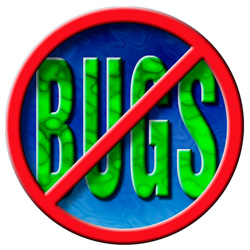 (Cue the horror music please!)
(Cue the horror music please!)
Remember those classic B-movies about bugs? The Fly, Eight-Legged Freaks, Slither, Them.... Well, they certainly come to my mind when bug season is in full swing with clouds of fruit flies, trails of ants, blood thirsty mosquitoes and the dreaded food moths. Since our dear birds can't be exposed to many of the very toxic commercially available bug killers its good to know that there are many alternative bird-safe, natural and inexpensive pest control methods we can use.
The best defense is a good offense when it comes to the war on bugs. Once they take hold it is generally a much more involved process to get rid of them especially since, as responsible stewards of our bird's health, we can't rely on the many commercially available and highly toxic solutions for pest control. By taking some precautionary measures you can eliminate or at least minimize pest problems. There are some general prevention principles that apply to the control of many insects:
- Determine how and where they are entering your home and seal cracks, repair torn screens, etc.
- Eliminate access to the food, water and breeding grounds that they need to survive.
- Refrigerate all perishable food, especially in the summer, when fruits and vegetables may spoil quickly.
- Make sure all the food in your house is sealed. Tightly wrap food set out on kitchen counters.
- Promptly clean up after meals and regularly take all trash out of your home.
- Move outdoor trash and recycling bins as far from your home as possible.
- There are also specific things you can do according to the type of insect you are trying to eliminate based on their behavior and life cycles as described in the following sections:
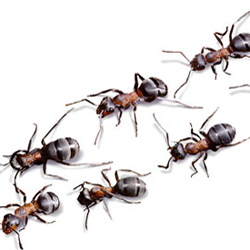 ANTS
ANTS
It is estimated that ants have been living on Earth for greater than 100 million years and that there are over 20,000 species of ants existing. Ants are hardy creatures and sometimes very difficult to eliminate. Ants live in social colonies and send out scouts from the colony to locate food and water. As the scouts travel they lay down a scent trail that enables the other members of the colony to travel to the found food source.
The key steps in preventing an ant infestation are to:
- Eliminate scent trails
- Remove food sources (keep counters and floors free of crumbs and other food bits)
- Block access into the house
Natural Remedies:
- Eliminate scent trails by wiping the countertops and hard floor surfaces where you have noticed ants with a 50% solution of vinegar.
- Ants will not cross various substances such as talcum powder or chalk therefore you can lay down a line of these materials across the point where ants are entering your house.
- Sprinkle cinnamon, black pepper, cayenne pepper, chili pepper, cloves or garlic or lemon juice wherever you've seen ants entering the house. The strong smells reportedly repel ants.
- Sprinkle used coffee grounds around the outside of your house. Again, the strong smell acts as a repellant.
- You can also use corn meal. The ants will carry it home and try to eat it, but they can't digest it properly and will die. Be sure to put corn meal wherever you see that the ants like to frequent. This method is especially great around pets or children, as corn meal by itself is not poisonous.
- Place bitter cucumber or citrus peels near the site of ant activity. Cucumber and citrus peels are toxic to the types of fungi that ants feed on, and therefore avoided by the ants.
- Pour boiling water over their mounds and into the cracks where they dwell.
- Ants won't cross soapy water so therefore you can set the legs of your bird's cage (or your dog's food bowl) in small pans of soapy water to keep ants from climbing up and eating their food.
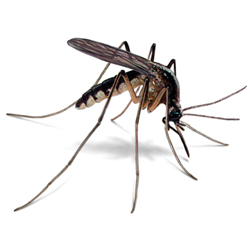 MOSQUITOES
MOSQUITOES
Swarming, blood sucking insects that carry disease have never ranked high on my list especially since the arrival of the West Nile Virus which kills birds and humans alike. West Nile is a virus transmitted by mosquitoes that can cause encephalitis, a condition that may lead to permanent disability or even death.
The key steps in preventing mosquitoes are to:
- Eliminate standing water around your property. Mosquitoes use standing water as breeding grounds. Change the water in outdoor bird baths, wading pools and pet water bowls every few days and put away yard items that collect water.
- Eliminate points of entry into your house by sealing window cracks and repairing town screens.
If you have an outdoor aviary you especially need to be concerned with mosquitoes:
- Avoid putting your birds outside in the early morning and early evening when mosquitoes are most active.
- Mosquitoes prefer still air so they are much less of a concern on breezy days. Consider placing a fan near your birds outside cage.
- Use mosquito netting over outdoor aviaries and cages.
- Burn citronella candles or torches while outside with your birds.
More Natural Remedies:
- Hang some bat houses in your yard. Mosquitoes are the primary source of food for many bat species. Some can eat up to 1,000 of the nasty little blood suckers an hour!
- Bird safe, non-toxic pheromone-based mosquito traps are commercially available.
- Several garden plants are known to repel mosquitoes. Why not plant some and beatify your yard at the same time?
- Citronella grass (source of citronella oil)
- Catnip - the oil from this plant has actually been found to be more than ten times better at repelling mosquitoes than DEET.
- Rosemary
- Marigolds have a particular smell that many insects find objectionable.
- Plant tansy or basil around patios, porches, windows, doors, or other areas that you want to keep mosquitoes away from.
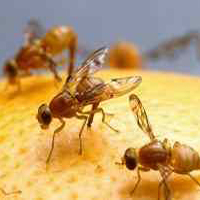 FRUIT FLIES
FRUIT FLIES
Fruit flies love little bits of rotting food. They choose to lay their eggs on just about anything they can find - especially on fruits and vegetables left on counters, in our bird's dishes or on their cage bottoms. Once these invaders find their way into our homes they are very difficult to overcome. The principal reason is that fruit flies are VERY prolific breeders and can lay up to 500 eggs at a time. Ugh! They also have the potential to contaminate food with dangerous bacteria.
Prevention:
- To eliminate fruit flies you have to cut off their food supply.....not so easy when we are all feeding our birds a daily regimen of fresh fruits and veggies. During fruit fly season feed fruit in smaller quantities and remove the uneaten portions within an hour.
- Wipe up spills and messes. Fruit flies are attracted by sugars. Use a water and bleach solution to wipe down counters.
- Sweep up tossed food bits and change cage bottoms frequently.
- Take out all garbage regularly so that any eggs don't hatch and develop into fruit flies. The life cycle from an egg into a adult flying fruit fly is under a week and then they only live 24 hours.
- Refrigerate all fruit and vegetables.
- Eliminate points of entry into your house by sealing window cracks, repairing torn window and door screens.
Removal:
- Fruit flies are attracted to vinegar. A jar with vinegar water left out overnight
- will lure them and they will then drown.
- Make a homemade fruit fly trap by placing a banana chunk in a clean odorless glass jar and tightly covering the jar with plastic wrap that has 5-6 fruit fly sized holes poked in the surface. Once a fruit fly crawls in, it can't get out.
- Use a commercially available pheromone based trap for mosquitoes.
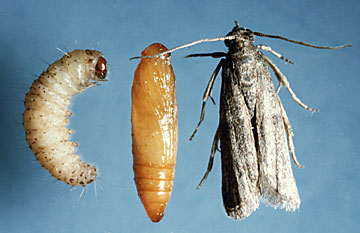 MOTHS
MOTHS
The Indian Meal Moth (aka Bird Seed Moth) does not feed on but rather lays eggs in grain and grain-based products. There are four stages in the life cycle of an Indian meal moth, starting with the egg phase. The larval stage causes the injury. Larvae are generally surface feeders but can feed within the grain. As they feed, larvae spin silken thread webbing throughout the infested food source. Small particles are often seen adhered loosely to the threads.
When full-grown, the larva migrate out of the food source and travel across walls and ceilings, making cocoons in cracks and crevices, emerging a few days later as adult moths. They are frequently found making cocoons in cracks and crevices on cupboard tops, shelves, ceiling corners, and walls. The complete life cycle from egg to adult moth takes one to two months.
Prevention & Remediation:
As with most insects, moths are easier to prevent than remediate.
- Prevent moths from getting inside your bird food by using air-tight storage containers. Don't use plastic bags as the adult moths are able to chew into this type of packaging.
- Upon bringing bird food home place it in the freezer for 3-4 days. The temperature will kill any eggs and larvae present in the food.
- If you see the tell-tale webbing in your parrot's food, throw it out
- Destroy cocoons and larvae that may be found in the cracks between shelves, moldings, and doorframes, on ceilings of cupboards, or where room walls and ceiling meet.
- Some herbs such as basil have been reported to repel seed moths. Place some basil leaves in your bird food storage container.
- Diatomaceous earth (use food grade only) will kill newly hatched larvae when mixed in your bird seed. Diatomaceous Earth is a fossilized deposit of microscopic shells created by one-celled plants called Diatoms. These plants inhabit all the waters of the earth, and serve as the basic food for aquatic life, just as grass is the basic food for land animals.
- Use a bird safe insecticide such as Camicide to kill adult moths. Camicide contains pyrethrins which are produced by certain species of the chrysanthemum plant and are known to be one of the safest ways to get rid of insects in your bird room. (Note: never spray Camicide directly on your parrot's food and remove your birds from any room while spraying aerosols of any type).
- Pheromone based Flour Moth Traps work without the need for insecticides. Pheromones lure the male moths into the trap where they become stuck and die. This reduces the breeding population of moths.
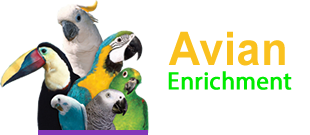






Comments powered by CComment